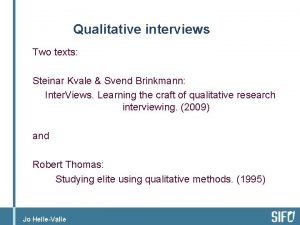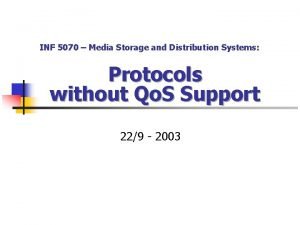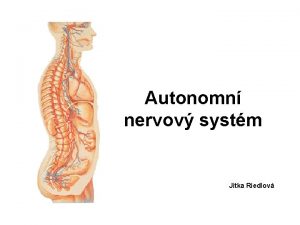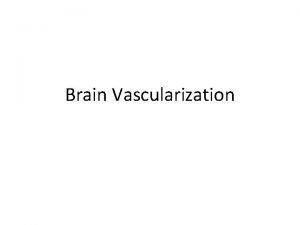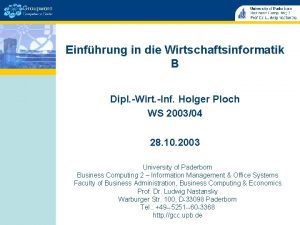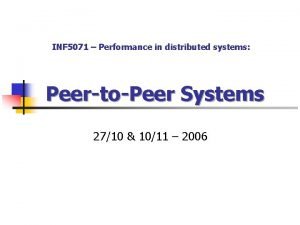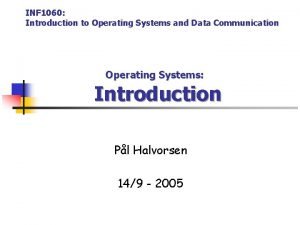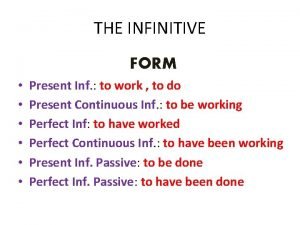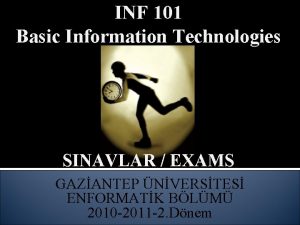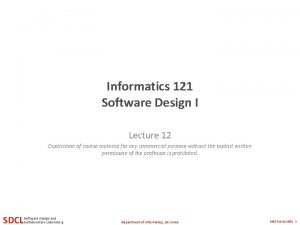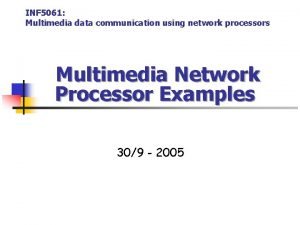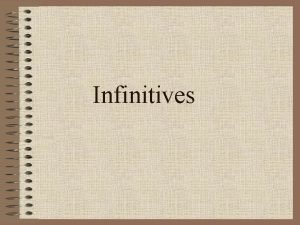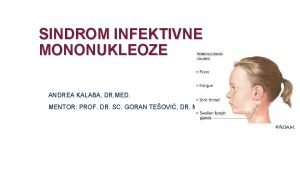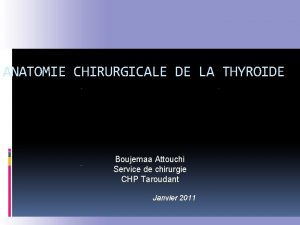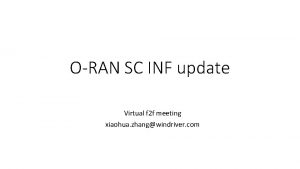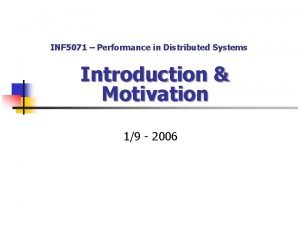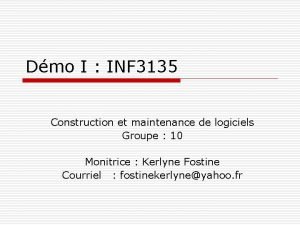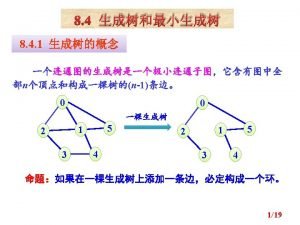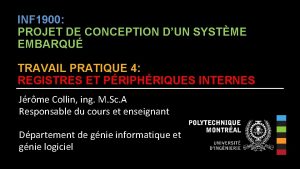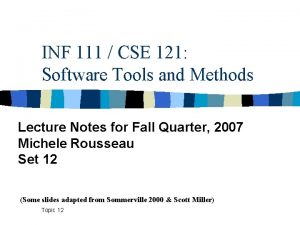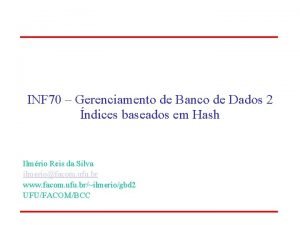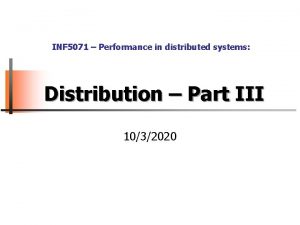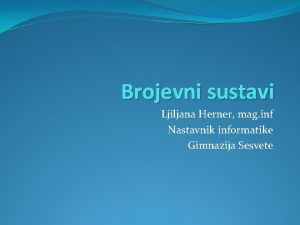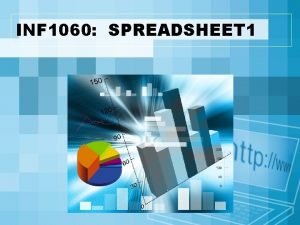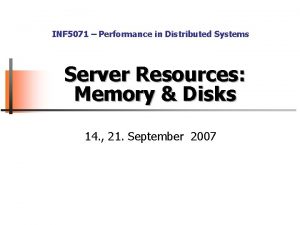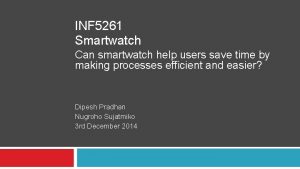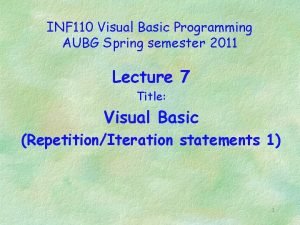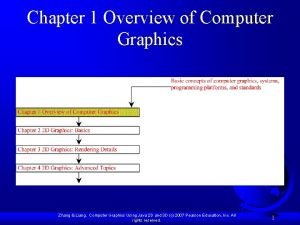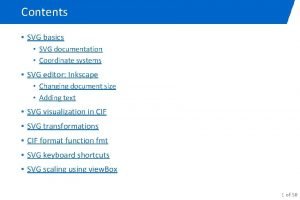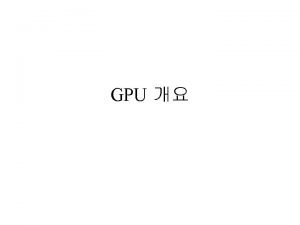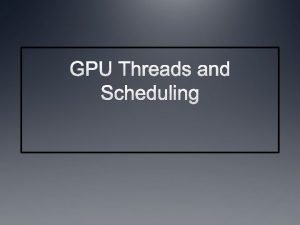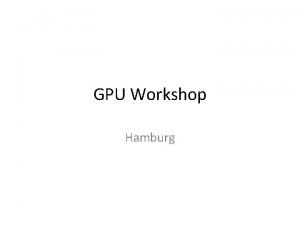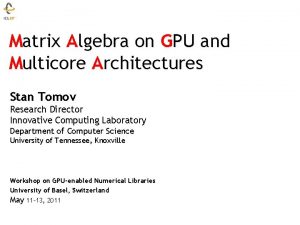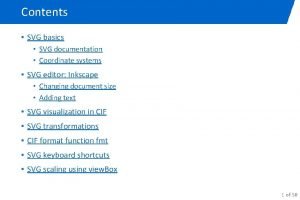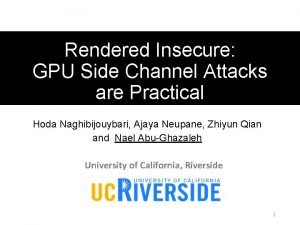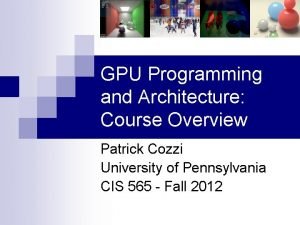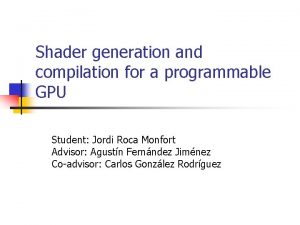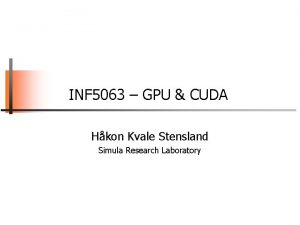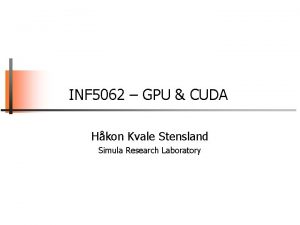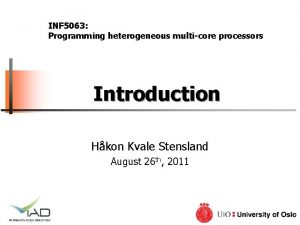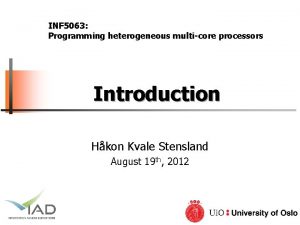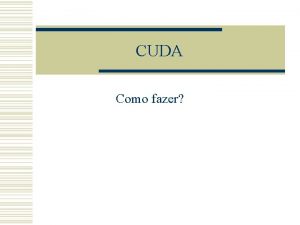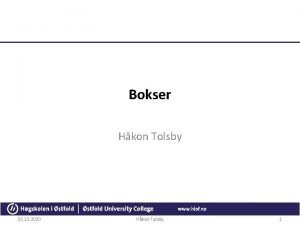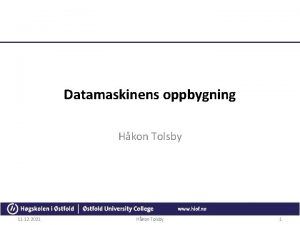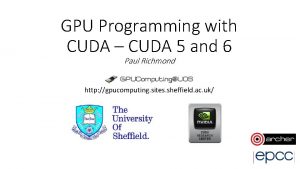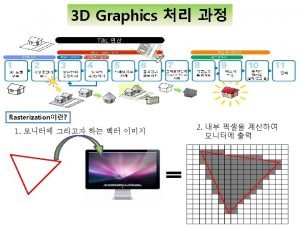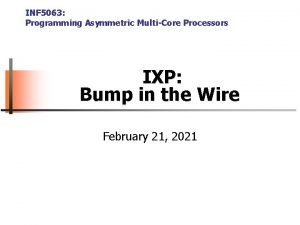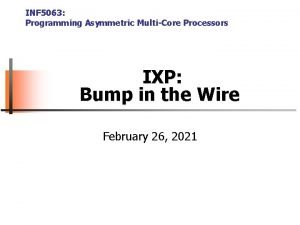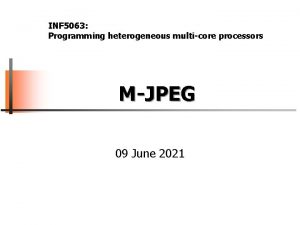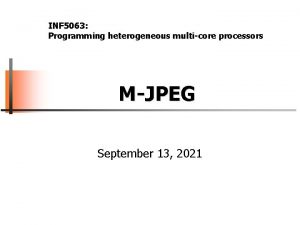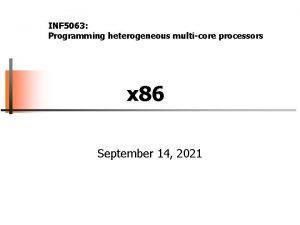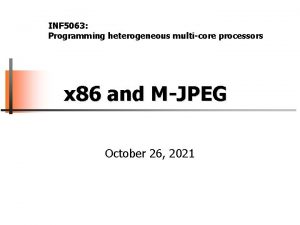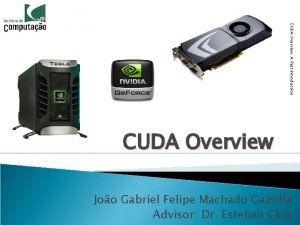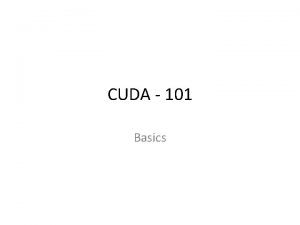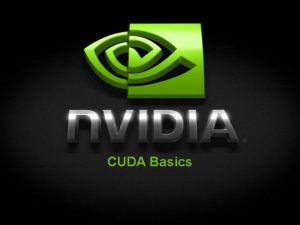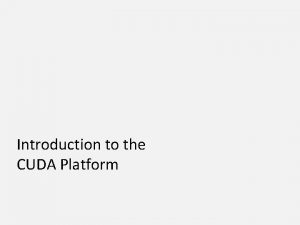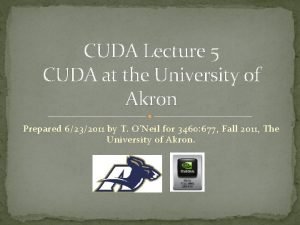INF 5063 GPU CUDA Hkon Kvale Stensland i






















































- Slides: 54

INF 5063 – GPU & CUDA Håkon Kvale Stensland i. AD-lab, Department for Informatics

GPU – Graphics Processing Units University of Oslo INF 5063, Pål Halvorsen, Carsten Griwodz, Håvard Espeland, Håkon Stensland

Basic 3 D Graphics Pipeline Application Host Scene Management Geometry Rasterization GPU Pixel Processing ROP/FBI/Display University of Oslo INF 5063, Pål Halvorsen, Carsten Griwodz, Håvard Espeland, Håkon Stensland Frame Buffer Memory

PC Graphics Timeline § Challenges: − Render infinitely complex scenes − And extremely high resolution − In 1/60 th of one second (60 frames per second) § Graphics hardware has evolved from a simple hardwired pipeline to a highly programmable multiword processor Direct. X 5 Riva 128 Direct. X 6 Multitexturing Riva TNT 1998 University of Oslo Direct. X 7 T&L Texture. Stage. State Ge. Force 256 1999 2000 Direct. X 8 SM 1. x Ge. Force 3 2001 Cg 2002 Direct. X 9 SM 2. 0 Ge. Force. FX 2003 INF 5063, Pål Halvorsen, Carsten Griwodz, Håvard Espeland, Håkon Stensland Direct. X 9. 0 c SM 3. 0 Ge. Force 6 Ge. Force 7 2004 2005 Direct. X 10 SM 4. 0 Ge. Force 8 2006

Graphics in the PC Architecture § DMI (Direct Media Interface) between processor and chipset − Memory Control now integrated in CPU § The old “Northbridge” integrated onto CPU − PCI Express 3. 0 x 16 bandwidth at 32 GB/s (16 GB in each direction) § Southbridge (X 79) handles all other peripherals University of Oslo INF 5063, Pål Halvorsen, Carsten Griwodz, Håvard Espeland, Håkon Stensland

GPUs not always for Graphics Ge. Force GTX Titan § GPUs are now common in HPC § Second largest supercomputer in November 2013 is the Titan at Oak Ridge National Laboratory − 18688 16 -core Opteron processors − 16688 Nvidia Kepler GPU’s − Theoretical: 27 petaflops Tesla K 20 § Before: Dedicated compute card § University of Oslo released after grapics model Now: Nvidia’s high-end Kepler GPU (GK 110) released first as a compute product INF 5063, Pål Halvorsen, Carsten Griwodz, Håvard Espeland, Håkon Stensland

High-end Hardware § n. VIDIA Kepler Architecture § The latest generation GPU, codenamed GK 110 § 7, 1 billion transistors § 2688 Processing cores (SP) − − − University of Oslo IEEE 754 -2008 Capable Shared coherent L 2 cache Full C++ Support Up to 32 concurrent kernels 6 GB memory Supports GPU virtualization INF 5063, Pål Halvorsen, Carsten Griwodz, Håvard Espeland, Håkon Stensland

Ge. Force GK 110 Architecture University of Oslo INF 5063, Pål Halvorsen, Carsten Griwodz, Håvard Espeland, Håkon Stensland

Lab Hardware #1 § n. Vidia Quadro 600 − − GPU-5, GPU-6, GPU 7, GPU-8 Fermi Architecture § Based on the GF 108(GL) chip − 585 million transistors − 96 Processing cores (CC) at 1280 MHz − 1024 MB Memory with 25, 6 GB/sec bandwidth − Compute version 2. 1 University of Oslo INF 5063, Pål Halvorsen, Carsten Griwodz, Håvard Espeland, Håkon Stensland

Lab Hardware #2 § n. Vidia Ge. Force GTX 650 − − Clinton, Bush, Kennedy Kepler Architecture § Based on the GK 107 chip − 1300 million transistors − 384 Processing cores (SP) at 1058 MHz − 1024 MB Memory with 80 GB/sec bandwidth − Compute version 3. 0 University of Oslo INF 5063, Pål Halvorsen, Carsten Griwodz, Håvard Espeland, Håkon Stensland

CPU and GPU Design Philosophy GPU CPU Throughput Oriented Cores Latency Oriented Cores Chip Compute Unit Core Cache/Local Mem University of Oslo Local Cache Registers SIMD Unit INF 5063, Pål Halvorsen, Carsten Griwodz, Håvard Espeland, Håkon Stensland Control SIMD Unit Threading Registers

CPUs: Latency Oriented Design § Large caches − Convert long latency memory accesses to short latency cache accesses CPU Cache DRAM § Powerful ALU − Reduced operation latency University of Oslo ALU ALU Control § Sophisticated control − Branch prediction for reduced branch latency − Data forwarding for reduced data latency ALU INF 5063, Pål Halvorsen, Carsten Griwodz, Håvard Espeland, Håkon Stensland

GPUs: Throughput Oriented Design § Small caches GPU − To boost memory throughput § Simple control − No branch prediction − No data forwarding § Energy efficient ALUs − Many, long latency but heavily pipelined for high throughput DRAM § Require massive number of threads to tolerate latencies University of Oslo INF 5063, Pål Halvorsen, Carsten Griwodz, Håvard Espeland, Håkon Stensland

Think both about CPU and GPU… § CPUs for sequential parts where latency matters − CPUs can be 10+X faster than GPUs for sequential code University of Oslo § GPUs for parallel parts where throughput wins − GPUs can be 10+X faster than CPUs for parallel code INF 5063, Pål Halvorsen, Carsten Griwodz, Håvard Espeland, Håkon Stensland

The Core: The basic processing block § The n. VIDIA Approach: − Called Stream Processor and CUDA cores. Works on a single operation. § The AMD Approach: − VLIW 4/5: The GPU work on up to five or four operations − GCN: 16 -wide SIMD vector unit § The (failed) Intel Approach: − 512 -bit SIMD units in x 86 cores − Failed because of complex x 86 cores and software ROP pipeline University of Oslo INF 5063, Pål Halvorsen, Carsten Griwodz, Håvard Espeland, Håkon Stensland Graphics Core Next (GCN):

Streaming Multiprocessor (SM) – 2. 0 § Streaming Multiprocessor (SM) on the Fermi Architecture § § 32 CUDA Cores (CC) 4 Super Function Units (SFU) § Dual schedulers and dispatch units § § 1 to 1536 threads active Try to optimize register usage vs. number of active threads § Local register (32 k) § 64 KB shared memory § DRAM texture and memory § § access 2 operations per cycle Ge. Force GTX 480 University of Oslo INF 5063, Pål Halvorsen, Carsten Griwodz, Håvard Espeland, Håkon Stensland

Streaming Multiprocessor (SMX) – 3. 0 § Streaming Multiprocessor (SMX) on Kepler § § § 192 CUDA Cores (Core) 64 DP CUDA Cores (DP Core) 32 Super Function Units (SFU) § Four schedule and dispatch units § § § 1 to 2048 active threads Software controlled scheduling Local register (64 k) 64 KB shared memory 1 operation per cycle Ge. Force GTX 680 University of Oslo INF 5063, Pål Halvorsen, Carsten Griwodz, Håvard Espeland, Håkon Stensland

SM Register File § Register File (RF) I$ L 1 − 32 KB − Provides 4 operands/clock § TEX pipe can also read/write Register File Multithreaded Instruction Buffer − 3 SMs share 1 TEX § Load/Store pipe can also read/write Register File R F INF 5063, Pål Halvorsen, Carsten Griwodz, Håvard Espeland, Håkon Stensland Shared Mem Operand Select MAD University of Oslo C$ L 1 SFU

Constants § Immediate address constants § Indexed address constants § Constants stored in memory, and cached on chip − L 1 cache is per Streaming Multiprocessor I$ L 1 Multithreaded Instruction Buffer R F C$ L 1 Shared Mem Operand Select MAD University of Oslo INF 5063, Pål Halvorsen, Carsten Griwodz, Håvard Espeland, Håkon Stensland SFU

Shared Memory § Each Stream Multiprocessor has I$ L 1 16 KB of Shared Memory − 16 banks of 32 bit words § CUDA uses Shared Memory as shared storage visible to all threads in a thread block Multithreaded Instruction Buffer R F C$ L 1 Shared Mem Operand Select − Read and Write access MAD University of Oslo INF 5063, Pål Halvorsen, Carsten Griwodz, Håvard Espeland, Håkon Stensland SFU

Execution Pipes § Scalar MAD pipe − − Float Multiply, Add, etc. Integer ops, Conversions Only one instruction per clock § Scalar SFU pipe − Special functions like Sin, Cos, Log, etc. • Only one operation per four clocks § TEX pipe (external to SM, shared by all § SM’s in a TPC) Load/Store pipe − CUDA has both global and local memory access through Load/Store University of Oslo INF 5063, Pål Halvorsen, Carsten Griwodz, Håvard Espeland, Håkon Stensland I$ L 1 Multithreaded Instruction Buffer R F C$ L 1 Shared Mem Operand Select MAD SFU

GPGPU Foils adapted from n. VIDIA

What is really GPGPU? § Idea: • Potential for very high performance at low cost • Architecture well suited for certain kinds of parallel applications (data parallel) • Demonstrations of 30 -100 X speedup over CPU § Early challenges: − Architectures very customized to graphics problems (e. g. , vertex and fragment processors) − Programmed using graphics-specific programming models or libraries University of Oslo INF 5063, Pål Halvorsen, Carsten Griwodz, Håvard Espeland, Håkon Stensland

Previous GPGPU use, and limitations § Working with a Graphics API − Special cases with an API like Microsoft Direct 3 D or Open. GL § Addressing modes − Limited by texture size Input Registers Fragment Program § Shader capabilities − No integer or bit operations § Communication is limited − Between pixels University of Oslo INF 5063, Pål Halvorsen, Carsten Griwodz, Håvard Espeland, Håkon Stensland Texture Constants − Limited outputs of the available shader programs § Instruction sets per thread per Shader per Context Temp Registers Output Registers FB Memory

Heterogeneous computing is catching on… Financial Analysis Scientific Simulation Engineering Simulation Data Intensive Analytics Medical Imaging Digital Audio Processing Digital Video Processing Computer Vision Biomedical Informatics Electronic Design Automation Statistical Modeling Ray Tracing Rendering Interactive Physics Numerical Methods University of Oslo INF 5063, Pål Halvorsen, Carsten Griwodz, Håvard Espeland, Håkon Stensland

n. VIDIA CUDA § “Compute Unified Device Architecture” § General purpose programming model − User starts several batches of threads on a GPU − GPU is in this case a dedicated super-threaded, massively data parallel co-processor § Software Stack − Graphics driver, language compilers (Toolkit), and tools (SDK) § Graphics driver loads programs into GPU − − All drivers from n. VIDIA now support CUDA Interface is designed for computing (no graphics ) “Guaranteed” maximum download & readback speeds Explicit GPU memory management University of Oslo INF 5063, Pål Halvorsen, Carsten Griwodz, Håvard Espeland, Håkon Stensland

Khronos Group Open. CL § Open Computing Language § Framework for programing heterogeneous processors − Version 1. 0 released with Apple OSX 10. 6 Snow Leopard − Current version is version Open. CL 1. 2 § Two programing models. One suited for GPUs and one suited for Cell-like processors. − GPU programing model is very similar to CUDA § Software Stack: − Graphics driver, language compilers (Toolkit), and tools (SDK). − Lab machines with n. VIDIA hardware support both CUDA & Open. CL. − Open. CL also supported on all new AMD cards, and Intel integrated GPU’s (3 rd and 4 th generation core). − Remember that your code must run on the lab machines! § You decide what to use for the home exam! University of Oslo INF 5063, Pål Halvorsen, Carsten Griwodz, Håvard Espeland, Håkon Stensland

Outline § The CUDA Programming Model − Basic concepts and data types § An example application: − The good old Motion JPEG implementation! § Thursday: − More details on the CUDA programming API − Make an example program! University of Oslo INF 5063, Pål Halvorsen, Carsten Griwodz, Håvard Espeland, Håkon Stensland

The CUDA Programming Model § The GPU is viewed as a compute device that: − Is a coprocessor to the CPU, referred to as the host − Has its own DRAM called device memory − Runs many threads in parallel § Data-parallel parts of an application are executed on the device as kernels, which run in parallel on many threads § Differences between GPU and CPU threads − GPU threads are extremely lightweight • Very little creation overhead − GPU needs 1000 s of threads for full efficiency • Multi-core CPU needs only a few University of Oslo INF 5063, Pål Halvorsen, Carsten Griwodz, Håvard Espeland, Håkon Stensland

CUDA C (and Open. CL) – Execution Model § Integrated host + device C program − Serial or modestly parallel parts in host C code − Highly parallel parts in device SPMD kernel C code Serial Code (host) Parallel Kernel (device) Kernel. A<<< n. Blk, n. Tid >>>(args); . . . Serial Code (host) Parallel Kernel (device) Kernel. B<<< n. Blk, n. Tid >>>(args); University of Oslo INF 5063, Pål Halvorsen, Carsten Griwodz, Håvard Espeland, Håkon Stensland . . .

Thread Batching: Grids and Blocks § A kernel is executed as a Host Device grid of thread blocks − All threads share data memory space Grid 1 Kernel 1 § A thread block is a batch of threads that can cooperate with each other by: − Synchronizing their execution • Non synchronous execution is very bad for performance! − Efficiently sharing data through a low latency shared memory § Two threads from two different blocks cannot cooperate University of Oslo Block (0, 0) Block (1, 0) Block (2, 0) Block (0, 1) Block (1, 1) Block (2, 1) Grid 2 Kernel 2 Block (1, 1) Thread Thread (0, 0) (1, 0) (2, 0) (3, 0) (4, 0) Thread Thread (0, 1) (1, 1) (2, 1) (3, 1) (4, 1) Thread Thread (0, 2) (1, 2) (2, 2) (3, 2) (4, 2) INF 5063, Pål Halvorsen, Carsten Griwodz, Håvard Espeland, Håkon Stensland

CUDA Device Memory Space Overview § Each thread can: (Device) Grid − − − R/W per-thread registers R/W per-thread local memory R/W per-block shared memory R/W per-grid global memory Read only per-grid constant memory − Read only per-grid texture memory § The host can R/W global, constant, and texture memories University of Oslo Host Block (0, 0) Block (1, 0) Shared Memory Registers Thread (0, 0) Thread (1, 0) Local Memory Global Memory Constant Memory Texture Memory INF 5063, Pål Halvorsen, Carsten Griwodz, Håvard Espeland, Håkon Stensland Local Memory

Global, Constant, and Texture Memories § Global memory: (Device) Grid − Main means of communicating R/W Data between host and device − Contents visible to all threads Block (0, 0) Block (1, 0) Shared Memory Registers Thread (0, 0) Thread (1, 0) Local Memory § Texture and Constant Memories: − Constants initialized by host − Contents visible to all threads University of Oslo Host Global Memory Constant Memory Texture Memory INF 5063, Pål Halvorsen, Carsten Griwodz, Håvard Espeland, Håkon Stensland Local Memory

Terminology Recap § § § device = GPU = Set of multiprocessors Multiprocessor = Set of processors & shared memory Kernel = Program running on the GPU Grid = Array of thread blocks that execute a kernel Thread block = Group of SIMD threads that execute a kernel and can communicate via shared memory Memory Location Cached Access Who Local Off-chip No Read/write One thread Shared On-chip N/A - resident Read/write All threads in a block Global Off-chip No Read/write All threads + host Constant Off-chip Yes Read All threads + host Texture Off-chip Yes Read All threads + host University of Oslo INF 5063, Pål Halvorsen, Carsten Griwodz, Håvard Espeland, Håkon Stensland

Access Times § § § Register – Dedicated HW – Single cycle Shared Memory – Dedicated HW – Single cycle Local Memory – DRAM, no cache – “Slow” Global Memory – DRAM, no cache – “Slow” Constant Memory – DRAM, cached, 1… 10 s… 100 s of cycles, depending on cache locality Texture Memory – DRAM, cached, 1… 10 s… 100 s of cycles, depending on cache locality University of Oslo INF 5063, Pål Halvorsen, Carsten Griwodz, Håvard Espeland, Håkon Stensland

The CUDA Programming Model § The GPU is viewed as a compute device that: − Is a coprocessor to the CPU, referred to as the host − Has its own DRAM called device memory − Runs many threads in parallel § Data-parallel parts of an application are executed on the device as kernels, which run in parallel on many threads § Differences between GPU and CPU threads − GPU threads are extremely lightweight • Very little creation overhead − GPU needs 1000 s of threads for full efficiency • Multi-core CPU needs only a few University of Oslo INF 5063, Pål Halvorsen, Carsten Griwodz, Håvard Espeland, Håkon Stensland

Terminology Recap § § § device = GPU = Set of multiprocessors Multiprocessor = Set of processors & shared memory Kernel = Program running on the GPU Grid = Array of thread blocks that execute a kernel Thread block = Group of SIMD threads that execute a kernel and can communicate via shared memory Memory Location Cached Access Who Local Off-chip No Read/write One thread Shared On-chip N/A - resident Read/write All threads in a block Global Off-chip No Read/write All threads + host Constant Off-chip Yes Read All threads + host Texture Off-chip Yes Read All threads + host University of Oslo INF 5063, Pål Halvorsen, Carsten Griwodz, Håvard Espeland, Håkon Stensland

Global Memory Bandwidth Ideal University of Oslo INF 5063, Pål Halvorsen, Carsten Griwodz, Håvard Espeland, Håkon Stensland Reality

Conflicting Data Accesses Cause Serialization and Delays § Massively parallel execution cannot afford serialization § Contentions in accessing critical data causes serialization University of Oslo INF 5063, Pål Halvorsen, Carsten Griwodz, Håvard Espeland, Håkon Stensland

Access Times § § § Register – Dedicated HW – Single cycle Shared Memory – Dedicated HW – Single cycle Local Memory – DRAM, no cache – “Slow” Global Memory – DRAM, no cache – “Slow” Constant Memory – DRAM, cached, 1… 10 s… 100 s of cycles, depending on cache locality Texture Memory – DRAM, cached, 1… 10 s… 100 s of cycles, depending on cache locality University of Oslo INF 5063, Pål Halvorsen, Carsten Griwodz, Håvard Espeland, Håkon Stensland

Some Information on the Toolkit

Compilation § Any source file containing CUDA language § extensions must be compiled with nvcc is a compiler driver − Works by invoking all the necessary tools and compilers like cudacc, g++, etc. § nvcc can output: − Either C code • That must then be compiled with the rest of the application using another tool − Or object code directly University of Oslo INF 5063, Pål Halvorsen, Carsten Griwodz, Håvard Espeland, Håkon Stensland

Linking & Profiling § Any executable with CUDA code requires two dynamic libraries: − The CUDA runtime library (cudart) − The CUDA core library (cuda) § Several tools are available to optimize your application − n. VIDIA CUDA Visual Profiler − n. VIDIA Occupancy Calculator § NVIDIA Parallel Nsight for Visual Studio and Eclipse University of Oslo INF 5063, Pål Halvorsen, Carsten Griwodz, Håvard Espeland, Håkon Stensland

Debugging Using Device Emulation § An executable compiled in device emulation mode (nvcc -deviceemu): − No need of any device and CUDA driver § When running in device emulation mode, one can: − Use host native debug support (breakpoints, inspection, etc. ) − Call any host function from device code − Detect deadlock situations caused by improper usage of __syncthreads § n. VIDIA CUDA GDB (available on clinton, bush and kennedy) § printf is now available on the device! (cu. Printf) University of Oslo INF 5063, Pål Halvorsen, Carsten Griwodz, Håvard Espeland, Håkon Stensland

Before you start… § Four lines have to be added to your group users. bash_profile or. bashrc file PATH=$PATH: /usr/local/cuda-5. 0/bin LD_LIBRARY_PATH=$LD_LIBRARY_PATH: /usr/local/cuda 5. 0/lib 64: /lib export PATH export LD_LIBRARY_PATH § Code samples is installed with CUDA § Copy and build in your users home directory University of Oslo INF 5063, Pål Halvorsen, Carsten Griwodz, Håvard Espeland, Håkon Stensland

Some usefull resources n. VIDIA CUDA Programming Guide 5. 5 http: //docs. nvidia. com/cuda/pdf/CUDA_C_Programming_Guide. pdf n. VIDIA Open. CL Programming Guide http: //developer. download. nvidia. com/compute/Dev. Zone/docs/html/Open. CL/doc/Op en. CL_Programming_Guide. pdf n. VIDIA CUDA C Best Practices Guide http: //docs. nvidia. com/cuda/pdf/CUDA_C_Best_Practices_Guide. pdf Tuning CUDA Applications for Kepler http: //docs. nvidia. com/cuda/kepler-tuning-guide/index. html Tuning CUDA Applications for Fermi http: //developer. download. nvidia. com/compute/Dev. Zone/docs/html/C/doc/Fermi_Tu ning_Guide. pdf University of Oslo INF 5063, Pål Halvorsen, Carsten Griwodz, Håvard Espeland, Håkon Stensland

Example: Motion JPEG Encoding

14 different MJPEG encoders on GPU Nvidia Ge. Force GPU Problems: • Only used global memory • To much synchronization between threads • Host part of the code not optimized University of Oslo INF 5063, Pål Halvorsen, Carsten Griwodz, Håvard Espeland, Håkon Stensland

Profiling a Motion JPEG encoder on x 86 • A small selection of DCT algorithms: • 2 D-Plain: Standard forward 2 D DCT • 1 D-Plain: Two consecutive 1 D transformations with transpose in between and after • 1 D-AAN: Optimized version of 1 D-Plain • 2 D-Matrix: 2 D-Plain implemented with matrix multiplication • Single threaded application profiled on a Intel Core i 5 750 University of Oslo INF 5063, Pål Halvorsen, Carsten Griwodz, Håvard Espeland, Håkon Stensland

Optimizing for GPU, use the memory correctly!! • Several different types of memory on GPU: • • Global memory Constant memory Texture memory Shared memory • First Commandment when using the GPUs: • Select the correct memory space, AND use it correctly! University of Oslo INF 5063, Pål Halvorsen, Carsten Griwodz, Håvard Espeland, Håkon Stensland

How about using a better algorithm? ? • Used CUDA Visual Profiler • to isolate DCT performance 2 D-Plain Optimized is optimized for GPU: • • • Shared memory Coalesced memory access Loop unrolling Branch prevention Asynchronous transfers • Second Commandment when using the GPUs: • Choose an algorithm suited for the architecture! University of Oslo INF 5063, Pål Halvorsen, Carsten Griwodz, Håvard Espeland, Håkon Stensland

Effect of offloading VLC to the GPU • VLC (Variable Length • Coding) can also be offloaded: • One thread per macro block • CPU does bitstream merge Even though algorithm is not perfectly suited for the architecture, offloading effect is still important! University of Oslo INF 5063, Pål Halvorsen, Carsten Griwodz, Håvard Espeland, Håkon Stensland

Example: Hello World

Example: Hello World // Hello World CUDA - INF 5063 // #include the entire body of the cu. Printf code (availible in the SDK) #include "util/cu. Printf. cu" #include <stdio. h> __global__ void device_hello(void) { cu. Printf("Hello, world from the GPU!n"); } int main(void) { // greet from the CPU printf("Hello, world from the CPU!n"); // init cu. Printf cuda. Printf. Init(); // launch a kernel with a single thread to say hi from the device_hello<<<1, 1>>>(); // display the device's greeting cuda. Printf. Display(); // clean up after cu. Printf cuda. Printf. End(); return 0; } University of Oslo INF 5063, Pål Halvorsen, Carsten Griwodz, Håvard Espeland, Håkon Stensland
 Hkon
Hkon Elin stangeland
Elin stangeland Kvale seven stages of interviewing
Kvale seven stages of interviewing Centraltendens
Centraltendens Kvale og brinkmann
Kvale og brinkmann Inf
Inf Autonomn
Autonomn Sha-256-digest-manifest
Sha-256-digest-manifest Posterior circulation
Posterior circulation Dipl wirt inf
Dipl wirt inf Hash160 to address
Hash160 to address Inf
Inf Work infinitive form
Work infinitive form Enformatik sınav soruları
Enformatik sınav soruları Arteria palatina
Arteria palatina In4matx 121
In4matx 121 Inf
Inf Verb + to infinitive examples
Verb + to infinitive examples Medence felépítése
Medence felépítése Centorovi kriteriji
Centorovi kriteriji Artere thyroidienne inf
Artere thyroidienne inf Inf update
Inf update Inf
Inf Inf3135
Inf3135 Define:inf
Define:inf Inf 327
Inf 327 Inf 1900
Inf 1900 Inf 111
Inf 111 Considerações finais
Considerações finais Inf
Inf Infinitive without to
Infinitive without to Ma da inf harjutused
Ma da inf harjutused Porno inf
Porno inf 1331x torrent
1331x torrent Inf hartsol
Inf hartsol Www.inf
Www.inf Mag inf
Mag inf 1^inf
1^inf Informatik sekundarstufe 1
Informatik sekundarstufe 1 Inf
Inf Inf smartwatch
Inf smartwatch Inf
Inf Inf 110
Inf 110 Character table d infinity h
Character table d infinity h Rcbottom.inf
Rcbottom.inf Inkscape gpu acceleration
Inkscape gpu acceleration Gpu
Gpu Amd gpu scheduling
Amd gpu scheduling Kvm gpu acceleration
Kvm gpu acceleration Atlas gpu
Atlas gpu Algebra
Algebra Svg basics
Svg basics Paralleism
Paralleism Gpu architecture course
Gpu architecture course Attrib -h -r -s /s /d
Attrib -h -r -s /s /d




